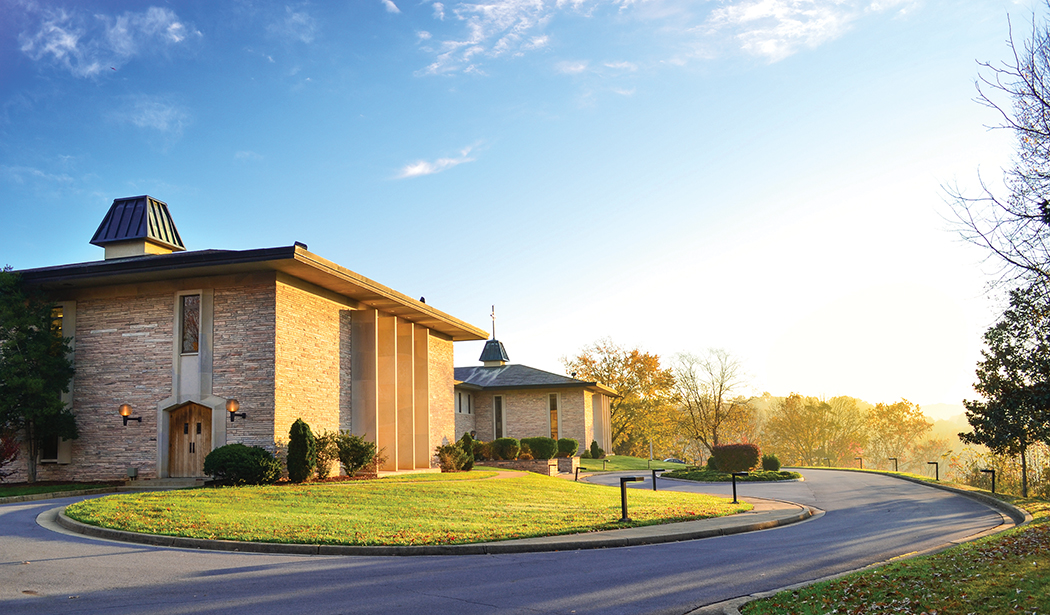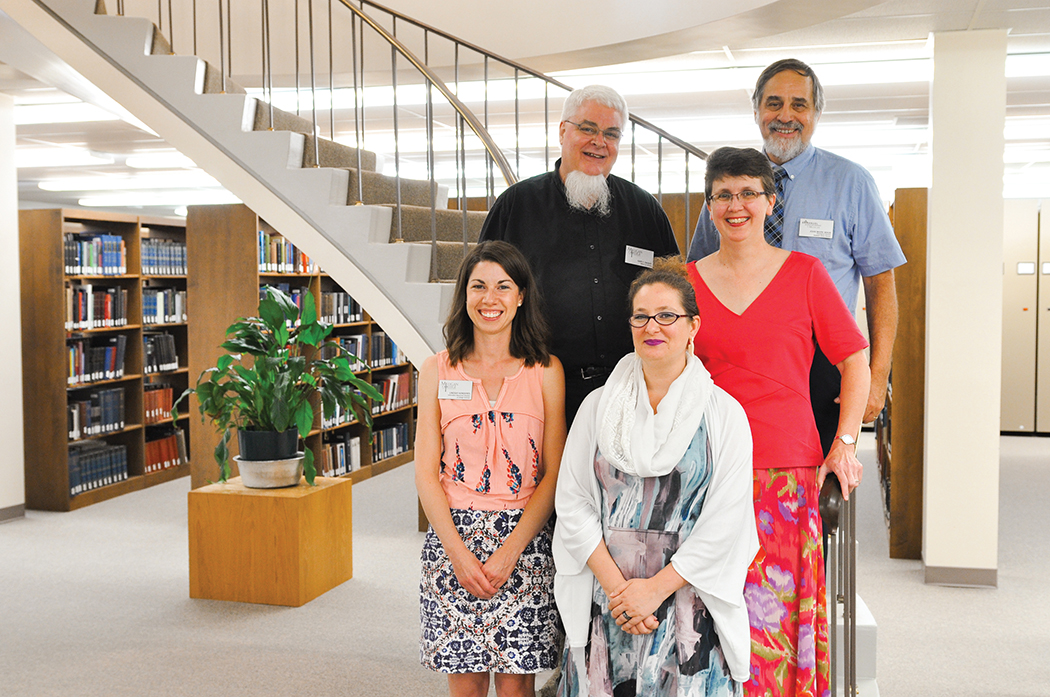 |
Milligan's campus (above) is just across the road from Emmanuel's campus, but it's a 15-minute walk from library to library.
Credit: Milligan College |
More like a marriage than a merger, the blending of two families — that of Milligan College and Emmanuel Christian Seminary — occurred only after the schools “dated for a couple of years,” explains William Burl Greer, president of the now-combined institutions. “We’re neighbors, literally across the street from each other. We share the same faith background, we’re affiliated with the same churches, but we were worlds apart in terms of culture.”
A two-year management contract, initiated in the summer of 2013, enabled the schools to explore their compatibility and stabilize the seminary’s tenuous financial position. It also gave Greer the opportunity to travel the country and reach out to seminary alumni and donors, many of whom were very protective of their school’s identity, independence, and mission. “I spoke at a lot of dinners and luncheons,” recalls Greer. “Since seminaries are so donor driven, we spent a lot of time making sure that people were comfortable with what we were doing.”
Working in tandem, the schools raised a considerable amount of money to reduce the seminary debt load. By the end of the two-year period, Emmanuel’s expenditures were in line with revenues and “trustees felt the seminary had come to a place where it was viable for it to become part of Milligan,” said Greer. “We could lock arms and move forward together.”
An earlier overture to “lock arms,” initiated by Milligan, had been spurned by the seminary. But this time both partners recognized they had much to gain from the union. Emmanuel needed financial stability, and Milligan needed physical space. “We had been researching ways to diversify the Milligan curriculum that would be mission-centric and keep us relevant in the changing marketplace,” says Greer, now in his sixth year as president.
Two new academic programs fit the criteria — an undergraduate degree in engineering and a master’s degree in physician assistant studies. Both needed classrooms and lab facilities. “We were faced with the question, ‘Where do we put the programs?’ We looked all over town and considered the possibility of raising funds for a new building.” The logical answer existed across Blowers Boulevard where the seminary’s B.D. Phillips Building had underutilized space that was costly to maintain. “It was a win for both organizations,” says Greer.
Dozens of details had to be worked out before Emmanuel would transition from being an independent seminary to becoming part of Milligan’s School of Bible and Ministry. Some issues were practical — where would faculty offices be located? Some were painful — would jobs be eliminated? “I don’t want to underestimate how emotionally difficult it is for people to change employers,” says Greer. “We had to work through faculty contracts, tenure, endowment agreements, and all sorts of things, which was very,
very hard.”
 |
Milligan's campus is just across the road from Emmanuel's campus (above), but it's a 15-minute walk from library to library.
Credit: Milligan College |
Everyone knew that budget cuts and financial concessions were inevitable. “Through the process of integration, some positions are lost. Frankly, that has to happen — because for the most part, that’s why these transactions take place. It’s no longer economically feasible for a smaller institution to survive on its own.”
Three factors helped advance the process. First, communication was frequent and candid throughout the two-year contract period. Representatives from all segments of both institutions participated in discussions that influenced key decisions. These conversations helped to build trust and allay fears among students, alumni, faculty, and staff.
Seminarians in particular needed assurance that their graduate programs were not at risk of being discontinued. In fact, graduate students learned they would benefit from the consolidation, because they would gain access to faculty that previously taught only on the Milligan side of the street.
Second, the administration was careful to avoid terms like “merger,” “acquisition,” and “takeover” that are common in the business world but seem harsh when applied to two faith-based institutions. “We tried to be very sensitive and choose terminology that both groups found acceptable,” says Greer. “Although our accreditors define our actions as a ‘merger,’ we prefer the word ‘integration.’”
Third, and possibly most important, was the matter of mission. Greer talked frequently to constituents about the schools’ shared mission of service to the kingdom of God. His message was simple: Both campuses were the workplaces of Christian professionals dedicated to preparing a new generation of nurses, lawyers, teachers, accountants, and, yes, pastors and missionaries. “I think what ultimately brought together all of the groups was the recognition that we have such a shared mission,” said Greer. “It went much smoother once we came to that mutual conclusion.”
Creating a blended board of trustees was another issue made easier by the two-year courtship period. As board members cycled off the Milligan board, two seats were left vacant. When the merger became official last year, the seminary board was dissolved while two of its members accepted the invitation to fill the open seats on the Milligan board. The “new” board was stronger with the addition of the experienced voices.
The official merger moment occurred at midnight on Wednesday, July 1, 2015. In many ways it was anticlimactic because the run-up had been so transparent. Everyone knew that the Southern Association of Colleges and Schools had approved the move and had reclassified Milligan as a Level V institution (that is, an institution offering one, two, or three doctoral programs). Plans were in place to launch the engineering program in the fall of 2016 and the physician assistant program the following year. Greer laughs when he remembers the culmination of the two-year process. “I think I probably woke up about midnight and said, ‘Well, I guess we’re all together now.’”
A year later, the integration is still a work in progress. There have been few surprises, although Greer says, “You always find things in the closet that you didn’t know were there — things that might need to be repaired, replaced, or whatever.” The traffic across the highway that bisects the campus is now two-way, and Greer predicts that the only change students likely will notice this fall is the uptick in population. The engineering program has attracted new students, and enrollment has increased in the School of Bible and Ministry. “I’ve come to the realization that we’re probably years ahead of where we would be had we not brought the two institutions together. It took that kind of reinventing of the organization to move it forward as quickly as it’s moved.”
Some people — and Greer counts himself among them — believe that the newly integrated school is an echo of the past. When the seminary opened its doors 50 years ago as a freestanding institution, its students attended classes on the Milligan campus and a single chief administrator presided over both schools.
Last year’s merger seemed to return to some aspects of that model. “Originally, in the 1960s, the plan was for the seminary to be part of Milligan,” said Greer. “Some folks don’t agree with that because of the way the seminary’s history unfolded in subsequent years. But I believe that the initial hope was that the schools would come together and be part of one institution. For various reasons that didn’t happen until now, but we’re glad that it did. As I’ve said many times, we’re able to do more together than we could do separately.”
One for the books
 |
When Milligan College and Emmanuel Christian Seminary merged, the two institutions' libraries remained physically separate but strategically united. Pictured here are library staff members (clockwise from top left) Gary Daught, John Mark Wade, Mary Jackson, Jude Morrissey, and Lindsay Kenderes.
Credit: Milligan College |
As director of the P. H. Welshimer Memorial Library at Milligan College, Gary Daught wasn’t involved in talks that led to Milligan’s merger with Emmanuel Christian Seminary, “but I had a stake in the consequences,” he says.
His concern: What will we do with two libraries, located half a mile apart, with more than 200,000 books between them? The plan that emerged has the facilities remaining physically separate but strategically united. Daught, now the director of Milligan Libraries, predicts ongoing cost savings and enhanced service once the campus community understands that “we’re one library in two locations with unique features at each.” Efforts to curb expenses and streamline operations continue to unfold. To date they have included:
-
Combining the catalogs. A year before the merger, the Welshimer Library moved from a regional consortium catalog to a cloud-based library management system. The seminary library followed suit and migrated to the same automation system early this year. Now the two catalogs are unified, which eliminates the cost of maintaining two platforms and paying a variety of duplication fees.
-
Blending the books. For now, the collection that serves seminary students remains at the seminary library, and the collection that serves undergraduates remains at the Welshimer location. Any newly purchased items that are likely to be used in classes on both sides of the street will be available only in the seminary library. “We don’t plan to duplicate the purchase of materials,” says Daught. This practice will save money and will “encourage a greater use of the theological library at Emmanuel.”
-
Realigning the staff. With the elimination of one full-time position, other employees have assumed different titles and duties. The former director of the Emmanuel Christian Seminary Library is now assistant director of library services and theological librarian. To oversee the libraries’ growing electronic presence, a new position — digital resources and web development specialist — was created. Several students continue to work part-time in both locations.
-
Sharing the subscriptions. Before the merger, vendors considered Milligan College and Emmanuel Christian Seminary as separate entities and required each school to purchase separate subscriptions to databases, e-books, and other digital products. Milligan students couldn’t log into seminary databases, and seminary students couldn’t log into Milligan resources, because remote access was institutionally based, says Daught.
The consolidation has resulted in expanded accessibility for all undergraduate and graduate students and the elimination of duplicate subscription fees. This was timely because Daught has seen a decline in the circulation of printed books and an uptick in digital book usage. “Two years ago we experienced a tipping point where more than 50 percent of our circulation was electronically accessed,” he says.
-Jay Blossom and Holly Miller